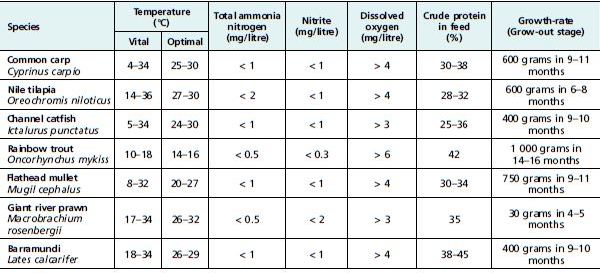7.3 WATER QUALITY FOR FISH
Periodical weight measurements will give the average growth rate of the fish, which will be obtained by subtracting the average fish weight, calculated above, over two periods.
The FCR is obtained by dividing the total feed consumed by the fish by the total growth during a given period, with both values expressed in the same weight unit (i.e. kilogram, gram).
Total feed/Total growth = FCR
The total feed can be obtained by summing all the recorded amount of feed consumed each day. The total growth can be calculated by simply multiplying the average growth rate by the number of the fish stocked in the tank.
At the grow-out stage, the feeding rate for most cultured fish (as discussed in this publication) is 1-2 percent of their body weight per day. On average, a 100 gram fish eats 1-2 grams of pelletized fish feed per day. Monitor this feeding rate at the same time as the FCR to determine growth rates and fish appetite and to help maintain overall system balance
Chapter 2 discussed water quality for aquaponics. Here, the most important water quality parameters are listed again briefly and summarized in Table 7.1.
7.3.1 Nitrogen
Ammonia and nitrite are extremely toxic to fish, and sometimes referred to as "invisible assassins". Ammonia and nitrite are both considered toxic above levels of 1 mg/litre, although any level of these compounds contributes to fish stress and adverse health effects. There should be close to zero detectable levels of both of these in a seasoned aquaponic system. The biofilter is entirely responsible for transforming these toxic chemicals into a less toxic form. Any detectable levels indicate that the system is unbalanced with an undersized biofilter or that the biofilter is not functioning properly. Ammonia is more toxic in warm basic conditions; if the pH is high, any detectable amount of ammonia is especially dangerous. Water tests for ammonia are called total ammonia nitrogen (TAN), and test for both types of ammonia (ionized and un-ionized). Symptoms of ammonia and nitrite poisoning are often seen as red streaking on the fish body, gills and eyes, scraping on the sides of the tank, gasping at the surface for air, lethargy and death. Nitrate on the other hand is much less toxic to most fish. Most species are able to tolerate levels of more than 400 mg/litre.
7.3.2 PH
Fish can tolerate a fairly wide range of pH, but do best at levels of 6.5-8.5. Substantial changes in pH in short periods (changes of 0.3 within a period of 12-24 hours) can be problematic or even lethal for fish. Therefore, it is important to keep the pH as stable as possible. Buffering with carbonate is recommended to prevent large pH swings.
7.3.3 Dissolved oxygen
Overall, as much DO as possible should be added to the aquaponic system. In practice, most fish require 4-5 mg/litre. Most domestic growers do not have the ability to check
the oxygen level in their units because digital oxygen meters are expensive and cheaper aquarium test kits are not widely available. Even so, following these recommendations ensures adequate DO levels. Do not overstock the fish, and refrain from adding more than 20 kg of fish per 1 000 litres of total water. Dynamic water flow, with cascading water falling back into the system, helps to aerate the water and add DO. Air pumps, if at all feasible, should be used. The suggested rate is 5-8 litres of air per minute for each cubic metre of water, coming from at least 2 air stones in different locations in the fish tank. Densely stocked units may require considerably more. Make sure that the water is not churned too vigorously or in a way that disrupts the fish swimming.
A clear sign for lack of oxygen is when fish are gasping for air at the surface. This behaviour, called piping, is when fish swim close to the surface of the water and take air into their mouths. This is an emergency situation that needs immediate attention. Backup (redundant) aeration systems are a valuable asset to an aquaponic system and can be used during power outages and equipment failures; simple battery backups for air pumps have saved countless fish throughout the industry.
7.3.4 Temperature
Fish are cold-blooded and, therefore, their ability to adjust to a large range of water temperatures is low. A steady temperature within their correct tolerance range keeps fish in their optimal conditions and aids fast growth and efficient FCR. In addition, optimal temperatures (and thus less stress) reduce the risk of diseases. Thermal isolation, water heaters and coolers help to achieve a steady temperature level, although these may be costly in areas where energy is expensive. It is often better to grow fish adapted to local environmental conditions. Each fish has an optimum temperature range that should be researched by the farmer. Generally, tropical fish thrive at 22-32 °C while cold-water fish prefer 10-18 °C. Meanwhile some temperate water fish have wide ranges, for example, common carp and largemouth bass can tolerate 5-30 °C.
7.3.5 Light and darkness
The light level in the fish tank should be reduced to prevent algae growth. However, it should not be completely dark, as fish experience fear and stress when a completely dark tank is exposed to sudden light when uncovered. The ideal condition is with indirect natural light through shading, which would both prevent algal growth and avoid stress to fish. It is also recommended to handle, harvest or grade fish in darkness to reduce fish stress to a minimum.
TABLE 7.1
Water quality parameters, feed requirement and expected growth rates for seven commercial aquatic species commonly used in aquaponics
